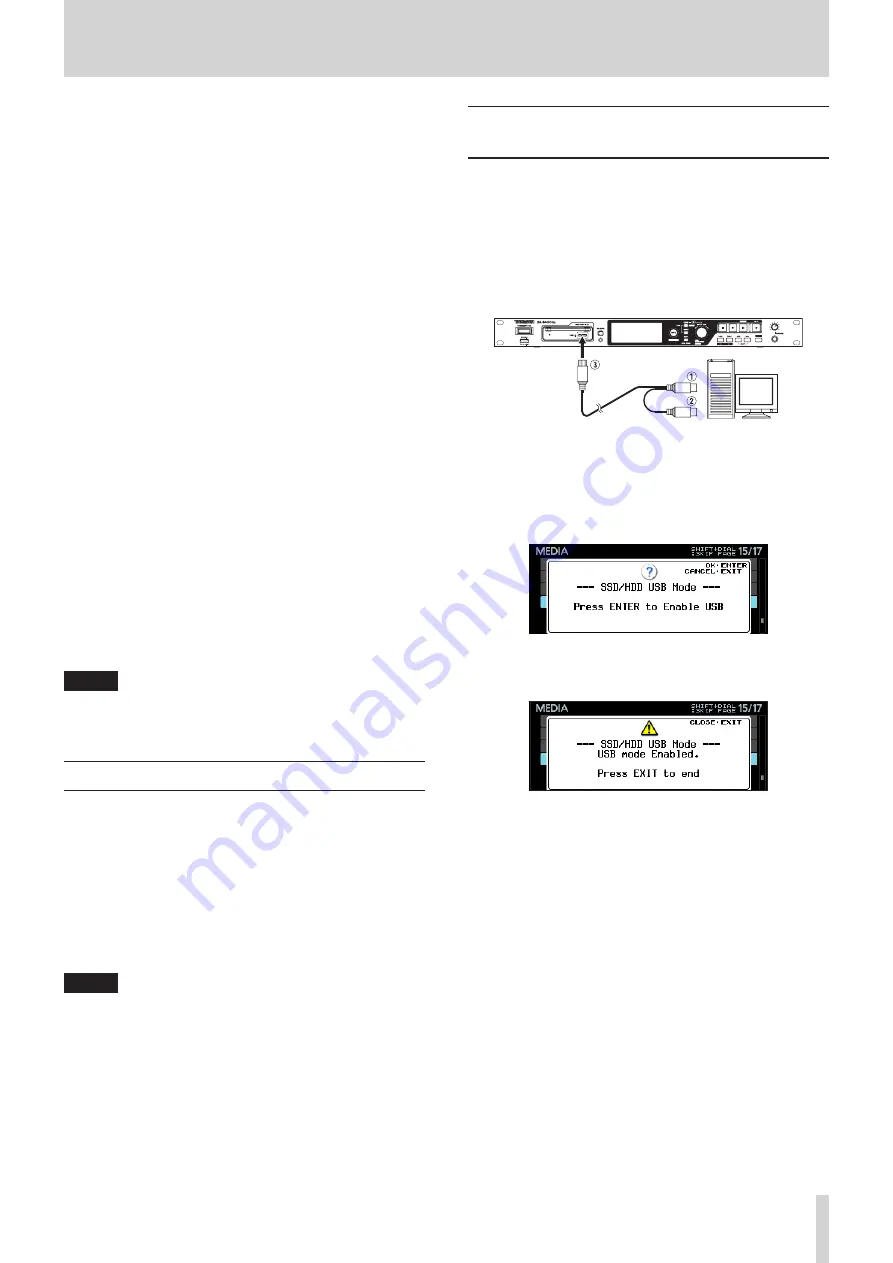
TASCAM DA-6400/DA-6400dp
49
10 – Data Transfer Using a Computer
By using a USB cable to connect the SSD/HDD case installed in
this unit to a computer, you can transfer data between them and
check the folder and file structure.
Changing or deleting files inside folders, or changing their
names, however, might make it impossible for the DA-6400 to
play back those folders. Be aware of this possibility.
8
Warning about copying files to computers
Be aware of the following precaution when copying files from a
DA-6400 SSD/HDD to a computer.
•
If you want to be able to play files properly on a DA-6400 at
a later date, copy complete folders and do not change their
structures.
Changing the folder structure or copying just BWF/WAV files
could make it impossible for the DA-6400 to play files back
properly with, for example, the correct number of channels
and take numbers.
8
Warning about copying files from computers
Be aware of the following precaution when copying files from a
computer to a DA-6400 SSD/HDD.
•
The DA-6400 can only play linear PCM WAV files with
sampling frequencies of 44.1, 48, 88.2 or 96 kHz and bit
depths of 16/24-bit. The DA-6400 cannot recognize files
other than WAV files and will ignore them.
•
Files with different sampling frequencies mixed together
in the same folder can be recognized as takes. Takes with
sampling frequencies that are different from that set on
the
REC Fs
screen, however, cannot be played back.
We recommend that you only keep files with the same
sampling frequency together in a folder whenever possible.
(See “Setting the recording file format” on page 25.)
•
Do not copy files larger than 2 GB to a DA-6400 SSD/HDD.
Doing so could cause operation of the DA-6400 to become
unstable and damage files on the SSD/HDD.
NOTE
The expression “computer” in the explanations in this
chapter refers to a Windows or Mac computer that this unit
supports.
Computer system requirements
This unit can be connected to the following types of computers.
8
Windows
Windows 10, Windows 8 (including 8.1), Windows 7
8
Mac
Mac OS X 10.2 or newer
When this unit and a computer are connected, the computer
will recognize this unit as a removable disk. No special driver is
necessary.
NOTE
Data is transfered between the SSD/HDD case and
computer at USB 3.0 speed (maximum). In order to achieve
USB 3.0 speed, you must use the included USB cable or a
commercially-available USB 3.0 (microB) cable and connect
to a port on the computer that supports USB 3.0.
Connecting an SSD/HDD to a
computer
By connecting the SSD/HDD case installed in this unit to a
computer, you can transfer audio data recorded by this unit to
the computer.
Use the USB 3.0 port to connect the SSD/HDD case and a
computer.
1. Use the included USB cable to connect the SSD/HDD case to
a computer in the order shown in the following illustration
(
1
w
2
w
3
).
2. On the
MEDIA
page, select the
SSD/HDD USB
CONNECT
item.
3. Press the
MULTI JOG
dial to open a confirmation pop-up
message.
4. Press the
MULTI JOG
dial.
The following pop-up message will appear.
5. Press the
MULTI JOG
dial to start the connection with the
computer. The following screen appears when connected to
a computer.
8
Precautions when connecting an SSD/HDD case and
a computer
•
Connect both type A connectors (
1
,
2
) on the included
USB cable to the computer.
Depending on the power supply capacity of the computer's
USB ports and the type of SSD/HDD drive installed in the
case, the power supply could be insufficient and the drive
might not function properly.
•
Connect both type A connectors (
1
,
2
) on the included
USB cable to the computer first. Then, connect the USB 3.0
microB connector (
3
) to the SSD/HDD case.
•
Do not connect the type A connectors (
1
,
2
) on the
included USB cable to an AC adapter or any 5V power
supply device other than the computer.
Connecting to a power supply device besides the computer
could damage all the equipment connected to the cable.






























